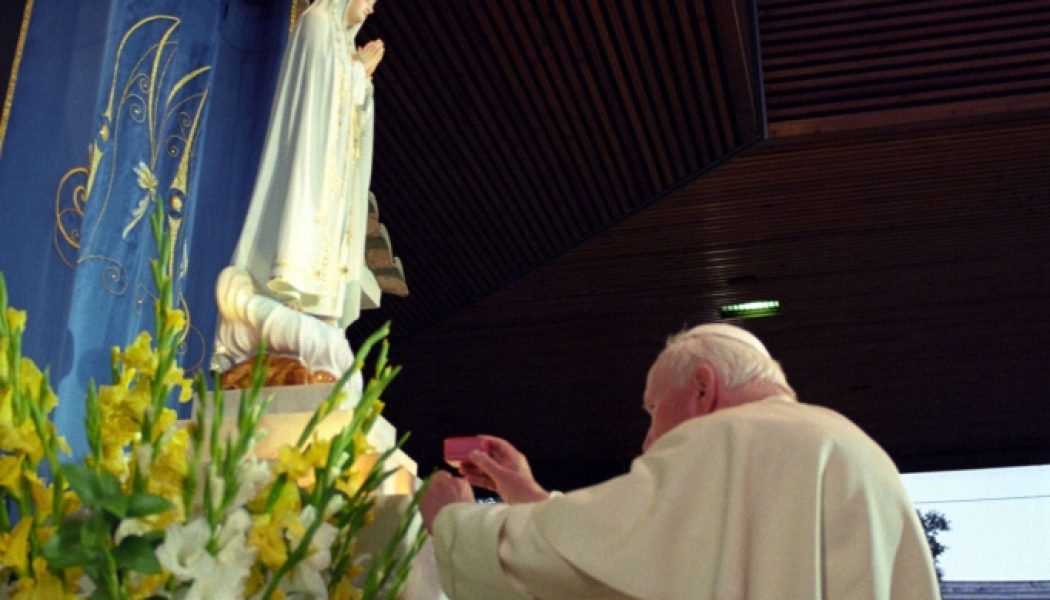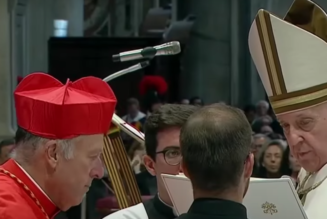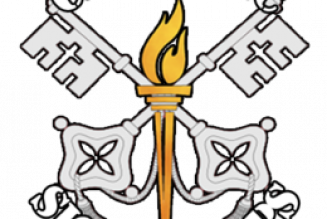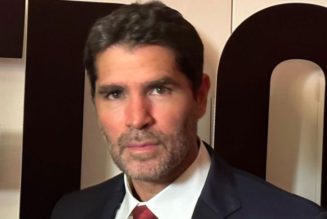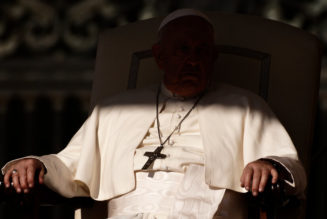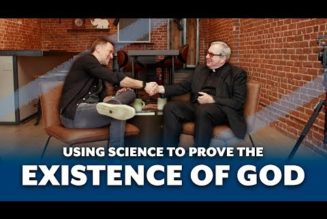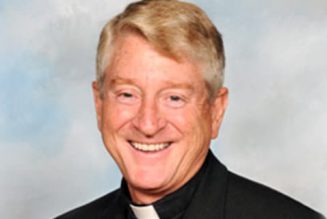
Pope John Paul II visits the Fatima Shrine in Portugal on May 13, 2000. (L’Osservatore Romano; Vatican Media/National Catholic Register)
Fatima, Pope St. John Paul II and God’s Providence
COMMENTARY: No shrine, save for those in the Holy Land, is more linked with the churnings of history than that of Our Lady of Fatima.
Father Raymond J. de Souza
Every shrine — from the first ones set up by patriarch Abraham on his journeys to the Marian sanctuaries today — is linked to history. What happened here, to make this a holy place? How did God act that makes this place one of privileged encounter with the workings of Providence?
No shrine, save for those in the Holy Land, is more linked with the churnings of history than that of Our Lady of Fatima. The “short 20th century” is usually dated from the October Revolution of 1917, which brought the Bolsheviks to power in Moscow. It concluded with the dissolution of the Soviet Union on Christmas Day 1991. One might then see in the 1917 apparitions at Fatima, Portugal, a preparation for the bloodiest of centuries. And the link between Fatima and Pope St. John Paul II is historical, too, for no figure in history was more consequential to the peaceful end of the totalitarian century than the Polish pope.
St. Paul VI visited Fatima in 1967 for the 50th anniversary of the apparitions. After the assassination attempt on the feast of Our Lady of Fatima, May 13, 1981, John Paul II visited Fatima exactly one year later to give thanks to Mary for saving his life. He would return on the 10th anniversary, May 13, 1991, for a second visit of thanksgiving.
Yet it was his visit of 20 years ago, on May 13, 2000, during the Great Jubilee, which made most explicit the link between Fatima and the true history of the 20th century.
The Jubilee Visit
The program for the Jubilee Year was so full that no papal trips were planned for that year, save for the epic pilgrimage to the biblical lands. Yet an exception was made for Fatima, which John Paul would visit for the feast on May 13. So important was this visit that later Benedict XVI would choose its 10th anniversary in 2010 for his own visit to Fatima. (Pope Francis would visit for the centennial of the apparitions, in 2017.)
At the beginning of the third millennium, John Paul wanted to underscore that God is at work in history, not only in the distant past but also today. And in particular, he was a witness to Providence, using his own life as an instrument.
The Lady and the Ring: The Prophecy of Wyszynski
That was made clear in a profound gesture that John Paul made immediately upon arriving in Fatima on the night of May 12, 2000. Praying before the statue of Our Lady of Fatima, he presented her with a gift. It was a ring that Cardinal Stefan Wyszynski had given to him upon his election as pope in 1978.
Cardinal Wyszynski was the towering primate of the Church in Poland for 33 years of war with the communist regime, 1948-1981. During the conclave of October 1978, Cardinal Wyszynski told his fellow Polish cardinal about the mission before him.
“At the beginning of my pontificate, Cardinal Wyszynski said to me: ‘If the Lord has called you, you must take the Church into the third millennium!’” John Paul revealed in 1994. “I understood then that I must take the Church of Christ into the third millennium with prayer and with different initiatives. However, I realized that this wasn’t enough. She had to be introduced with suffering, with the attack. The Pope had to be attacked; he had to suffer so that every family, so that the world, would see that there is, so to speak, a higher Gospel, the Gospel of suffering.”
John Paul’s mission was in mortal danger on May 13, 1981, when he was cut down by the bullet of a professional assassin. At the same time Cardinal Wyszynski was dying in Warsaw. The last conversation the two would have by phone would be from their respective hospital beds. Cardinal Wyszynski would die on May 28.
John Paul would survive the assassination attempt. He attributed his miraculous survival to the protection of Our Lady of Fatima. As a concrete sign of that thanksgiving, he gave one of the bullets that struck him to the bishop of Fatima; the bishop had it installed in the crown of Our Lady’s statue.
When, during the Jubilee Year, John Paul presented the ring given to him by Cardinal Wyszynski, it was another act of thanksgiving. He had completed the mission prophesied by the great Polish primate. He survived in order to do so because of the intercession of Our Lady of Fatima. If he had vanquished Soviet communism along the way and liberated his homeland, that, too, was because of the maternal protection shown on the Fatima feast day in 1981.
Thus the Fatima visit of 20 years ago linked together the heroic Polish resistance, the prophesy of Wyszynski, the miraculous survival of the assassination attempt and the defeat of communism, all framed by a jubilee act of thanksgiving to the Lord of history.
Cardinal Wyszynski was to have been beatified June 7 in Warsaw. Due to the coronavirus pandemic, the beatification has been postponed.
The Third Secret
On that same jubilee visit to Fatima, John Paul beatified Jacinta and Francisco Marto, the shepherd children who saw Our Lady in 1917 and died a few years later. Pope Francis would canonize them on his visit in 2017.
But the big news of the jubilee visit was John Paul’s decision to reveal the “third secret” of Fatima, a prophetic vision granted to the children by the Blessed Virgin and only revealed to the pope. John Paul had read the secret and meditated upon it when convalescing after the assassination attempt of 1981.
The vision of the “third secret” was of an enormous number of martyrs, a veritable mountain of them. A “bishop clothed in white” was killed in the vision. John Paul identified the martyrs as those of the 20th century, the greatest century of Christian martyrdom. He saw himself in the bishop who was killed — an interpretation confirmed by Sister Lucia, the surviving visionary. But he survived — and attributed his survival to the intercession of Our Lady: “One hand fired the bullet; another hand guided it.”
“The Holy Father wishes his pilgrimage to be a renewed gesture of gratitude to Our Lady for her protection during these years of his papacy,” Cardinal Angelo Sodano, then the Vatican’s secretary of state, read in a statement during that jubilee trip to Fatima. “This protection seems also to be linked to the so-called ‘third part’ of the secret of Fatima.”
“The vision of Fatima concerns above all the war waged by atheist systems against the Church and Christians, and it describes the immense suffering endured by the witnesses to the faith in the last century of the second millennium,” Cardinal Sodano continued. “The successive events of 1989 led, both in the Soviet Union and in a number of countries of Eastern Europe, to the fall of the communist regime which promoted atheism. For this, too, His Holiness offers heartfelt thanks to the Most Holy Virgin.”
Stating that “the events to which the third part of the secret of Fatima refers now seem part of the past,” Cardinal Sodano’s intervention was later elaborated in an official commentary by Cardinal Joseph Ratzinger. The revelation of the secret was also intended, in the words of papal biographer George Weigel, “to dampen down some of the more dramatic forms of Catholic apocalypticism during the millennium year.”
It can be difficult to remember now, but conspiracy theories about the “third secret” were a cottage industry during the Cold War and into the 1990s. Even after the jubilee Fatima visit and subsequent Ratzinger commentary, there were critical voices still accusing the Holy See of hiding the full truth about Fatima. Even confirmations from Sister Lucia herself were not adequate to satisfy the committed sceptics, some of whom seemed to think that even John Paul himself was too soft on Soviet communism!
Even 20 years later, the temptation of apocalypticism never completely disappears. Archbishop Carlo Maria Viganò, whose original “testimony” about the Theodore McCarrick case included reckless accusations about dozens of prelates, recently granted an interview in which he asserted that the “third secret” is yet to be fully revealed. Archbishop Viganò’s comments arise from that sector of Catholic opinion that has never accepted the presentation of the Fatima visions given by St. John Paul II and Benedict XVI.
A subsequent declaration, which Archbishop Viganò drafted and released this month, also tends toward a sensational reading of history that is at odds with the measured reading of Providence that St. John Paul II offered at Fatima 20 years ago.
St. John Paul II’s witness at Fatima teaches that Providence is at work always and sometimes can be glimpsed in extraordinary ways. But the desire for the sensational and conspiratorial is to be resisted. The extraordinary events, open to the eyes of faith, are more than sufficient.
Father Raymond J. de Souza is the editor in chief of Convivium magazine.
